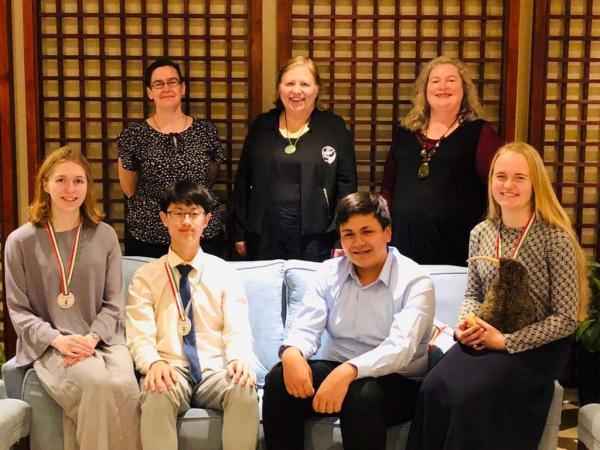News
Published 29 July 2019Hungarian Happiness
The 30th International Biology Olympiad has been held in Szeged, Hungary from the 14th to the 21st of July. The NZ team of Sophie Bebelman (Sancta Maria College, Auckland), Anneke Cummacke (Diocescan School for Girls, Auckland), Carlos Mendonca (Onslow College, Wellington) and Zi Lin Wang (Macleans College, Auckland) have been competing with students from 72 different countries.

2019 Team
The New Zealand team has completed a range of practical tasks from dissecting chicken wings, to keying out native Hungarian grasses to using molecular biology to run gels using electrophoresis.
All of the assessments allowed students to learn while challenging their ability to interpret current worldwide biological research.
Anneke Cummack, and Zi Lin Wang gained Silver medals, Sophia Bebelman was awarded a Bronze medal and Carlos Mendonca, a Highly Commended.
This is a huge achievement for the New Zealand team and a tribute to their dedicated study over 18 months and the support of their teachers, whānau and the NZIBO committee and university partners.
In addition, the team has explored Budapest and Szeged, seen storks and their nests, climbed to the top of a cathedral, boated on the Danube and had a go at Hungarian dancing.
The chance to meet students from around the globe, share their enthusiasm for Biology and laugh across language boundaries has been immense.
The team lead by Dr Angela Sharples (Murupara Area School), Dr Heather Meikle (Palmerston North Girls’ High School) and Ms Michelle Isbister (Hauraki Plains Area School) are impressed by the nature of the team, their curiosity and ability to support each other in this challenging situation.
Students keen to take part in the NZ International Biology Olympiad programme and potentially attend the 31st IBO in Nagasaki, Japan should enroll at www.nzibo.org
More information about the 30th IBO and NZIBO can be found at: https://www.facebook.com/NZBiologyOlympiad
